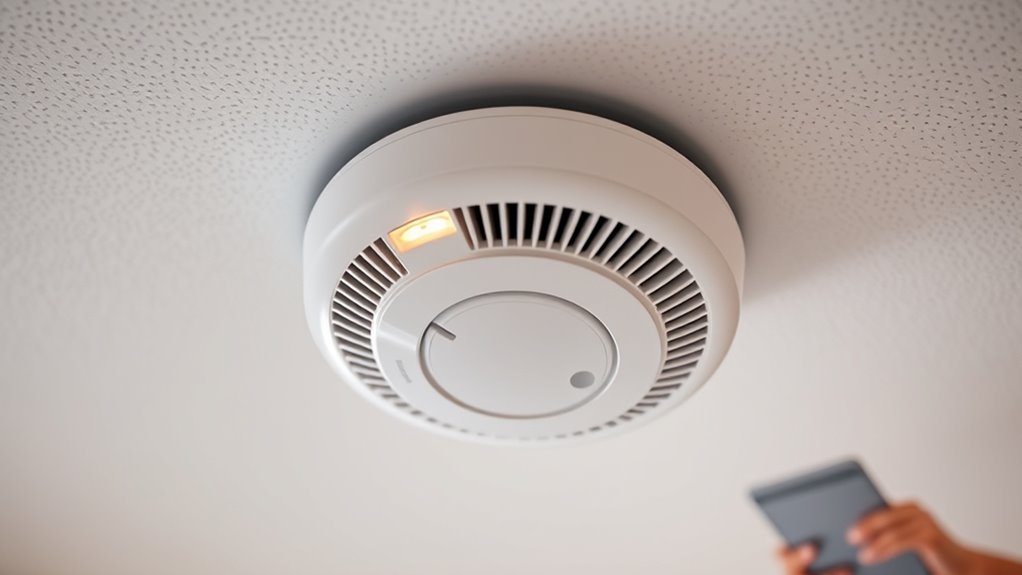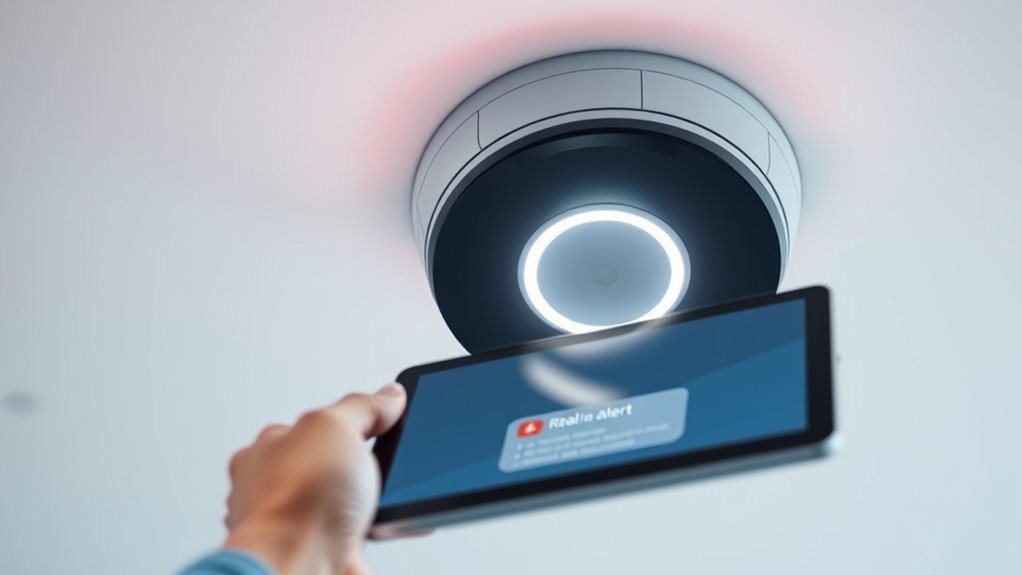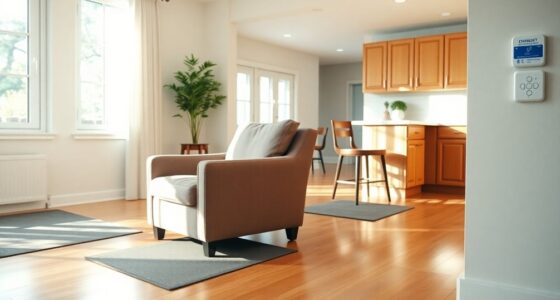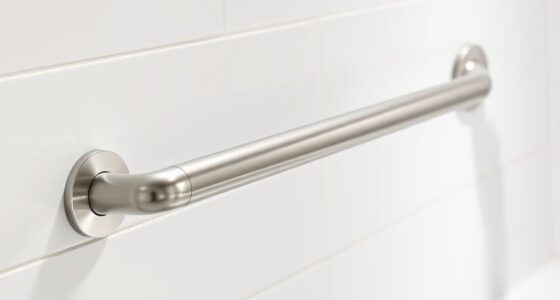Smart smoke and CO alarms instantly alert your care team and family whenever they detect hazards, no matter where you are. They connect to your Wi-Fi and send real-time notifications to your phones or devices, enabling quick responses. With advanced sensors, these alarms distinguish between gases and smoke, reducing false alarms. Plus, they integrate with other smart home systems for all-encompassing safety. Keep going to find out how these features work together to keep everyone safe.
Key Takeaways
- Smart alarms send instant alerts to care teams via Wi-Fi or connected devices during emergencies.
- Real-time notifications enable prompt response, reducing risks and potential harm.
- Integration with smart home systems allows automated safety measures and coordination.
- Detailed alert logs assist care teams in monitoring and analyzing safety patterns.
- Continuous device monitoring ensures alarms are operational, ensuring reliable alerts for care teams.

Have you ever wondered if your smoke and carbon monoxide alarms are really keeping you safe? It’s easy to assume that a loud beep or flashing light is enough to alert you to danger, but traditional alarms have limitations. They only sound an alert in your home, leaving you to discover the problem after the fact or when it’s too late. That’s where smart smoke and CO alarms come into play, transforming how you protect yourself and your loved ones. These devices are designed to connect to your Wi-Fi network, giving you real-time updates and instant alerts no matter where you are. If a fire starts or dangerous levels of carbon monoxide are detected, you’ll receive an immediate notification on your phone, tablet, or other connected device. This way, you don’t have to rely solely on hearing the alarm inside your house; you can respond quickly from anywhere, whether you’re at work, on vacation, or asleep.
Smart alarms also offer additional features that traditional alarms lack. Many are equipped with sensors that can distinguish between different types of smoke or gases, reducing false alarms caused by burnt toast or steam. They often integrate with other smart home systems, allowing you to automate responses, such as turning on fans or *unlatch* doors, to help manage emergencies more effectively. Plus, many models come with voice alerts, which can specify whether there’s smoke or carbon monoxide, giving you clearer information to act on. Some alarms even monitor the overall health of the device itself, notifying you when it needs a battery change or maintenance, ensuring you’re always protected. These devices often utilize specialized sensors to enhance detection accuracy and reliability.
Smart alarms detect different gases, reduce false alerts, and integrate with smart home systems for proactive safety management.
Another significant benefit is the ease of setup and maintenance. Most smart alarms connect effortlessly to your home Wi-Fi and come with companion apps that guide you through installation and ongoing management. These apps often provide detailed logs of past alerts, helping you identify patterns or recurring issues. Maintenance is simplified too, with features like automatic firmware updates that keep your device current with the latest safety enhancements. Because they’re interconnected, multiple alarms can communicate with each other, creating a *thorough* safety network within your home. If one alarm detects danger, all connected units can activate simultaneously, ensuring maximum awareness. This interconnectedness provides a layer of security that traditional standalone alarms simply can’t match.
In short, smart smoke and CO alarms give you peace of mind by offering instant, reliable alerts to your phone or other devices, enabling you to respond faster and more effectively. They represent a significant upgrade over traditional alarms, combining advanced technology with user-friendly features that keep you safer, wherever you are.
Frequently Asked Questions
How Do Smart Alarms Differentiate Between False Alarms and Real Threats?
You can rely on smart alarms to distinguish false alarms from real threats by using advanced sensors and algorithms. They analyze smoke density, gas levels, and environmental factors to reduce false alerts. When a genuine threat is detected, they send instant notifications to your care team. This smart technology ensures you get alerted only for real dangers, minimizing unnecessary panic and ensuring prompt response when it matters most.
Can Smart Smoke and CO Alarms Be Integrated With Existing Home Automation Systems?
Like a skilled conductor, smart smoke and CO alarms can seamlessly integrate with your existing home automation system. You just need to check if they’re compatible and follow the setup instructions. Most modern alarms connect via Wi-Fi or Zigbee, allowing you to control and monitor them through your smart hub or app. This integration helps you stay connected, ensuring safety is always just a tap away.
What Is the Typical Battery Life for These Smart Alarms?
You can typically expect smart smoke and CO alarms to last about 5 to 7 years on their built-in batteries. Some models have replaceable batteries that need changing annually, while others come with sealed, long-lasting batteries. To guarantee safety, check your alarm’s specific manufacturer guidelines. Regular testing and maintenance help keep your alarms functioning properly, giving you peace of mind and early alerts in case of danger.
How Do Alerts Get Transmitted to Care Teams in Remote Areas?
You might think a simple alarm would do, but these smart alarms send alerts via Wi-Fi or cellular networks, even in remote areas. When smoke or CO is detected, they instantly notify your care team through connected apps or text messages. So, even miles away, your care team gets a real-time warning, proving that modern technology can bridge even the greatest gaps—no smoke signal required.
Are There Specific Regulations or Certifications for Smart Smoke and CO Alarms?
Yes, smart smoke and CO alarms often need to meet specific regulations and certifications. You should look for UL (Underwriters Laboratories) or ETSI (European Telecommunications Standards Institute) certifications, which guarantee safety and reliability. Additionally, compliance with local building codes and standards like NFPA (National Fire Protection Association) in the U.S. is essential. These certifications verify that the alarms are tested and meet strict safety requirements, giving you confidence in their performance.
Conclusion
With smart smoke and CO alarms, you’re not just sleeping soundly; you’re having a vigilant guardian watching over your home. These alarms act like an alarm bell in the night, waking you instantly when danger lurks. They connect you to your care team like a trusted lighthouse guiding ships safely to shore. Embrace this technology and transform your safety from a flickering candle to a blazing beacon, ensuring peace of mind is always just a breath away.









